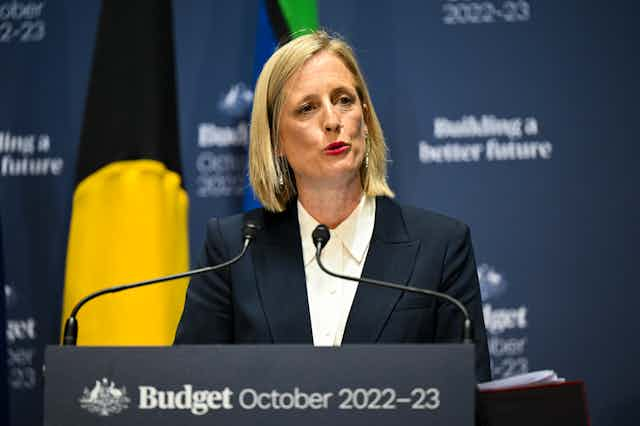The Labor federal government promised it would make women central to its first budget.
The inclusion of an evidence-based women’s budget statement shows a greater awareness of the systemic challenges, particularly to women’s economic security. The statement sets out a number of systemic issues that must be addressed to ensure women achieve economic equality.
But the policies still need work.
The headline items: childcare and paid parental leave
In a year when dealing with inflation has taken priority over supporting low-income Australians, the headline items are increased access to childcare and paid parental leave.
The childcare measures are fulfilling an election promise. Legislation is already before parliament to increase the rate of the childcare subsidy from 85% to 90% for a family with one child where the family income is less than $80,000.
The changes to paid parental leave were also announced ahead of the budget. This proposal will increase paid parental leave from 20 to 26 weeks, with an extra two weeks being available each year from July 1 2023 to July 1 2026. The Morrison government’s March 2022 budget proposed some changes, but the increased time is a new measure.
Read more: Paid parental leave extended to 26 weeks by 2026, with pressure on dads to share more early caring
The current government has acknowledged that the former government’s proposals for flexibility would reinforce stereotypical gender roles. It has stated there will be a use-it-or-lose-it allocation for dads and partners, but has not identified how the increased allocation will be shared between parents. This has been referred to the Womens’ Economic Equality Taskforce for further advice.
While the use-it-or-lose-it component is important to promote shared parenting, the rate of payment, at minimum wage, is a further deterrent to dads taking advantage of the scheme. There’s no proposal to increase the rate of payment to a rate closer to replacement wage, and again there’s no commitment to pay superannuation on paid parental leave.
The changes to childcare and paid parental leave are welcomed as necessary to retain women’s attachment to the paid labour market during the critical period of family formation: following childbirth and before the children attend school.
However, there’s little support for other families in this budget, particularly those families who will be doing it tough as inflation and interest rate rises erode their take-home income.
About $1.7 billion has been allocated to women’s safety over four years. Respect@Work initiatives have been allocated $42.5m, new “working women’s centres” have been allocated $32m, and there’s $65m for consent and respectful relationships education in schools.
The National Plan to End Violence Against Women and Children has been allocated $1.3 billion. The detail of these measures is still thin as the underlying action plan is under development, but prevention measures must be included.
Funding for the national plan illustrates the approach the government has taken to reviewing programs from the previous government with funding from those measures being redirected to new, “better targeted” commitments.
A first step
The women’s budget statement piloted gender impact analysis to identify policies that affect women negatively compared to men. Gender impact analysis is an important step toward gender responsive budgeting. It can identify how mainstream programs can be designed to be inclusive and take account of the needs of women, as well as where a gender specific program is needed.
Read more: Applying a gender lens to the budget need not pit women against men
The Office for Women piloted gender impact analysis in several policy areas including the housing needs of women, apprenticeship and training data, and the child care reforms.
For example, gender impact analysis was applied when writing the government submission to the Fair Work Commission for the Aged Care Work Value Case.
This budget goes on to include gender equity as an object of the Fair Work Act, and to establish Pay Equity and Care and Community Sector expert panels at the Fair Work Commission. This will focus attention on the issues around pay rates in the care sector which has a predominantly female workforce. Improving pay rates will also increase the rate of male employment resulting in a more gender balanced workforce.
However, the matter of how to fund higher wages in the care sector hasn’t been specifically addressed in this budget. While the service provider will pay the increased wages cost, this will create a cost pressure point in the system.
Budget Paper 1 included a statement on “Measuring What Matters”, which discusses how to develop a framework for wellbeing budgeting. It’s important gender indicators are taken into account in developing the wellbeing budget framework, but the work on gender responsive budgeting must also continue.
The women’s budget is headed in the right direction, but there needs to be capacity building across the public service to ensure systemic issues are addressed across portfolios.

